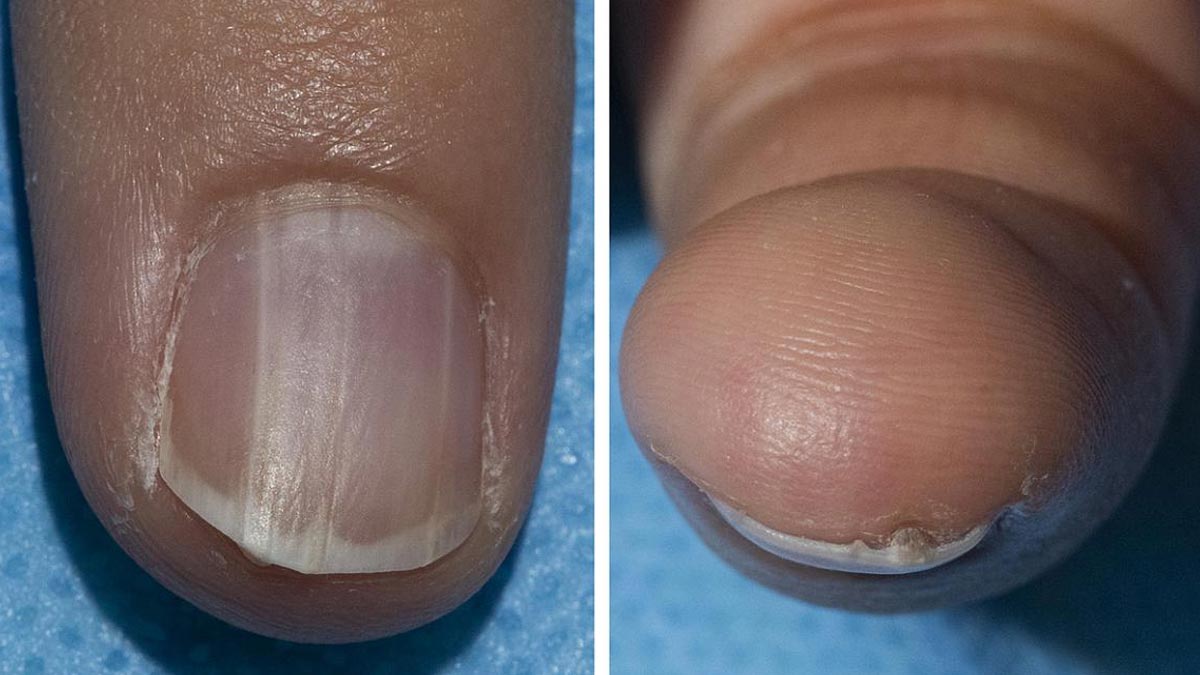
Researchers at the National Institutes of Health (NIH) have identified a benign nail abnormality that may indicate the presence of a rare inherited disorder, BAP1 tumour predisposition syndrome. This condition significantly elevates the risk of developing cancerous tumours in the skin, eyes, kidneys, and mesothelium, which lines the chest and abdomen.
Table of Content:-
As per the overview, BAP1 tumour predisposition syndrome is caused by mutations in the BAP1 gene, which typically functions as a tumour suppressor. These findings, published in JAMA Dermatology, were presented at the Society for Investigative Dermatology Annual Meeting in Dallas.
The discovery emerged from a study involving participants undergoing screening for BAP1 variants at the NIH Clinical Centre. The study included annual dermatology screenings for participants aged 2 and older. The current study involved 47 individuals with BAP1 tumour predisposition syndrome from 35 families.

Nail Health Signals Cancer Risk
During a baseline genetic assessment, a participant reported subtle changes in his nails, prompting researchers to investigate further. Biopsies revealed the presence of onychopapilloma, a benign tumour characterised by a coloured band (usually white or red) along the nail, nail thickening, and thickening at the end of the nail. Typically, onychopapilloma affects only one nail.
However, among study participants with BAP1 tumour predisposition syndrome aged 30 and older, 88% had onychopapilloma affecting multiple nails. This suggests that nail screening could be particularly valuable for individuals with a personal or family history of melanoma or other BAP1-associated cancers.
Here’s What The Experts Are Saying
"This condition is rarely seen in the general population. We believe that the presence of nail changes indicating onychopapillomas on multiple nails should prompt consideration of a BAP1 tumour predisposition syndrome diagnosis," said Dr Edward Cowen, Head of Dermatology Consultation Services, NIH’s National Institute of Arthritis and Musculoskeletal and Skin Diseases (NIAMS).
Dr Raffit Hassan, co-senior author and Principal Investigator of the clinical protocol highlighted the significance of multidisciplinary teams and natural history studies in uncovering insights about rare diseases.
Also Read: Skin Cancer: Why Are Men More Likely To Die From Melanoma Than Women?

Melanoma Symptoms
As per the World Health Organisation, melanoma is a serious form of skin cancer that can be life-threatening if not detected early. While obvious changes in moles or skin lesions are commonly associated with melanoma, there are several more subtle signs that individuals should be aware of. Recognising these early signs can be crucial for timely diagnosis and treatment.
Beyond this benign nail condition, other subtle signs point towards melanoma. Talking to the Onlymyhealth team, Dr Ajay Rana, Dermatologist & Aesthetic Physician and Founder & Director, ILAMED listed a few:
- Changes in Existing Moles: Changes like one half of the mole doesn't match the other half, edges of the mole are ragged, notched, or blurred, colour variations, moles larger than 6 millimetres, changes in size, shape, colour, or elevation of a mole, or any new symptom such as bleeding, itching, or crusting.
- New Moles or Spots: The appearance of a new mole or skin lesion, especially if it looks different from your other moles (often referred to as the "ugly duckling sign").
- Unusual Pigmentation: Dark streaks or spots under a fingernail or toenail not caused by injury.
- Non-Healing Sores: A sore that doesn’t heal or keeps recurring in the same spot.
- Changes in Sensation: Itchiness, tenderness, or pain in a mole or skin lesion.
- Redness or Swelling: Redness or a new swelling beyond the border of a mole.
- Surface Changes: A mole that starts to ooze, bleed, become scaly, or develop a lump or bump.
- Satellite Moles: The appearance of new moles or pigment near an existing mole.
Also Read: Mole Or Melanoma: How To Tell If It Is Just a Mole Or An Underlying Skin Cancer
The discovery of a benign nail condition as a potential indicator of cancer underscores the importance of paying attention to subtle changes in nail health. Regular nail screenings, particularly for individuals with a personal or family history of melanoma or other BAP1-associated cancers, can facilitate early detection and timely intervention. As highlighted by the NIH researchers, this finding could pave the way for improved diagnostic practices and better outcomes for those at risk. Paying close attention to both obvious and subtle signs of melanoma remains critical in the fight against skin cancer.
Also watch this video
Read Next
Regularly Adding Table Salt To Food Linked To 41% Higher Risk Of Gastric Cancer, Study Reveals
How we keep this article up to date:
We work with experts and keep a close eye on the latest in health and wellness. Whenever there is a new research or helpful information, we update our articles with accurate and useful advice.
Current Version